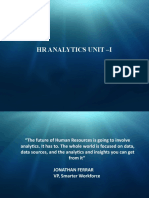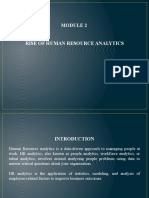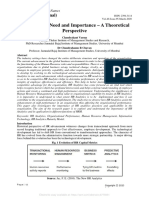HR ANALYTICS
SYLLABUS
• Defining HR Analytics, Role of Analytics, HR Analytics: The Third
Wave for HR value creation, HR Measurement journey in tune
with HR maturity journey , Understanding the organizational
system (Lean) , Locating the HR challenge in the system , Valuing
HR Analytics in the organizational system, Typical problems
(working session).
� HR ANALYTICS
• HR analytics, also referred to as people analytics, workforce
analytics, or talent analytics, involves gathering together,
analyzing, and reporting HR data. It enables your organization to
measure the impact of a range of HR metrics on overall business
performance and make decisions based on data. In other words,
HR analytics is a data-driven approach toward Human Resources
Management.
�ROLE & IMPORTANCE OF HR ANALYTICS
• Data-driven decision-making: HR analytics enables organizations to
make more informed and data-driven decisions regarding their
workforce. By analyzing various HR metrics, such as employee turnover,
engagement, performance, and recruitment data, HR professionals can
identify patterns and trends that inform strategic decisions.
• Predictive insights: With HR analytics, organizations can move beyond
simply reporting past data to predict future outcomes. For instance,
predictive analytics can help forecast employee turnover rates, identify
potential flight risks, and even anticipate skill gaps in the organization.
• Talent acquisition and recruitment: HR analytics can help improve
the recruitment process by identifying the most effective sourcing
channels, optimizing job descriptions, and streamlining the candidate
selection process. This can lead to better candidate matches and
reduced time-to-fill vacancies.
�CONT
• Employee engagement and retention: Understanding what drives
employee engagement and retention is crucial for a healthy work
environment. HR analytics can help identify factors that contribute to high
or low engagement levels, allowing organizations to take proactive
measures to retain their top talent.
• Performance management: HR analytics can provide insights into
employee performance, helping managers and HR professionals identify
high-performers and areas where performance can be improved. This
information can be used to implement effective performance management
strategies and foster a culture of continuous improvement.
• Learning and development: By analyzing training data and performance
metrics, HR analytics can help organizations identify skill gaps and training
needs. This enables the design of targeted learning and development
programs that align with business goals and employee career aspirations.
�CONT
• Diversity and inclusion: HR analytics can aid in assessing diversity and
inclusion efforts within an organization. It can help identify areas for
improvement, track progress, and ensure that the workplace is inclusive and
representative of diverse talent.
• Cost optimization: Analyzing HR data can help organizations identify areas
where costs can be optimized, such as reducing turnover-related expenses,
minimizing overtime costs, and optimizing workforce scheduling.
• Aligning HR with business strategy: HR analytics allows HR departments
to align their strategies with broader organizational goals. By understanding
how HR practices impact business outcomes, HR professionals can contribute
more effectively to the overall success of the company.
• Mitigating risks and compliance: HR analytics can help identify potential
HR-related risks and compliance issues, such as employee misconduct or HR
policy violations. Early detection allows for proactive measures to mitigate
these risks and maintain a compliant work environment.
� HR ANALYTICS: THE THIRD WAVE FOR HR VALUE
CREATION
• Lead the Value (understand the organization in detail,
functionality, interaction with manpower)
• Managing the value ( align the vision , mission with day
to day task)
• Market the value (projection to stake holders,
organization as a brand, market potential of the
organization, question on if it is a investable brand).
�HR MEASUREMENT JOURNEY IN TUNE WITH HR
MATURITY JOURNEY
�Evolution of HR Analytics
• Traditional HRM (1900-1970)
• Strategic HRM (1980- onwards)
• HR Analytics(2010 onwards)
�Traditional HRM
• Personnel Management(1900-1935)
• Taylor’s scientific management- time and motion study- job analysis
• Personnel departments were established,
• Responsible for employee-related issues
• Robust personnel selection system
�Traditional HRM
• Industrial Relations Phase(1935-45)
• Continuous power struggle between union leaders and management
• HR - mainly involved in dealing with unions and labour disputes.
• HR maintenance phase(1945-70)
• Record keeping, maintenance of data of recruitment, training and
benefits.
• Maintaining legal compliances
�Strategic Phase & HR Analytics
Phase
• All activities and functions of HR that add business value and
enhances efficiency - SHRM.
• Analytical HRM-
Automation in HR process(payroll and data management)
Adoption of computers
Fast-paced internet access
ERP
�HR MEASUREMENT JOURNEY IN TUNE WITH HR
MATURITY JOURNEY
�UNDERSTANDING THE ORGANIZATIONAL SYSTEM
(LEAN)
• Lean methodology is an agile management approach to
creating more valuable outcomes by refining workflows.
It eliminates wasteful or redundant actions by gauging
quality at each step, so every function of the
organization operates efficiently. Stakeholders are well
connected in the decision-making process to generate a
culture of continuous improvement that streamlines
processes and leverages talent.
�CONT
• Lean HR management assesses the value of its
service environment by asking questions, such
as:
• Is there a process in place for the tasks of each service?
• Is the process being followed?
• Are there ways to alter it or steps that could be
eliminated to make it more efficient?
�CONT
• An organization’s primary source of value is its employees. HR’s
responsibility is to frame a system and environment that
influences an optimal workforce to support business
performance. The ultimate goal of lean HR is to continuously
work toward eliminating redundancy and waste in HR processes
and HR service delivery.
• HR departments should partner with leadership to promote a lean
mindset for the entire organization. In addition, it must operate
its own services as efficiently as possible, striving for continuous
process improvement.
�CONT
� EXAMPLES OF NON VALUE ADDING ACTIVITIES IN
HR
• Inventory – (Storing redundant or obsolete data.) Look for ways
to purge expired information and reduce the need for keeping
hard copies of employee/candidate files, etc.
• Waiting – (Work is stalled while waiting for specific information
or others to complete their part of the process.) Review required
signatures/approvals to standardize only those necessary. Cross-
trained employees can cover for each other to maintain
workflow.
• Excess processing – (Handling tasks or data that don’t add
value for the customer.) Look for ways to avoid needless approval
layers, reports, and data re-entry.
�CONT
• Motion – (Unnecessary movement of people or goods.)
Ergonomic equipment placement, easily referenced file and
supply systems, and keeping team members in close proximity
can save people time between tasks.
• Transportation – (Processes that involve traveling through too
many connections.) Teams and organizations can avoid this type
of waste by streamlining report routing, reducing email
attachments, and omitting the distribution of hardcopies.
• Talent – (Underuse of employees’ abilities.) Empower employees
to accomplish more. Provide them with adequate tools and
training and authorize them to implement process improvements
within the scope of their responsibilities.
�CONT
• Defects – (Errors in the process or negative outcomes that need
revamping.) For instance, a lack of standardized work
procedures that lead to data entry errors or a faulty hiring
method that results in high turnover and needs reworking.
• Overproduction – (Generating information that is not needed or
ever used or supplying more of something than needed or before
it’s required.) Assessing the use and value of all information and
reports and establishing workflow sequences, standards, and
signals for each process will pinpoint this type of waste.
� BENEFITS OF LEAN HR
• Applying a lean HR model creates many advantages for organizations in any
industry by improving processes for all stakeholders and encouraging continuous
improvement. You’re able to identify bottlenecks and then redesign procedures to
remove them. This leads to considerable benefits, including:
• Cost reduction – Cutting waste saves money, so a lean focus maximizes profits.
• Quality enhancement – An attention-to-detail mindset optimizes workflow and
reduces errors.
• A development culture – When people focus their thinking on seeking change
for the better, it promotes an environment of being open to progress and taking
pride in adding value with their work.
• Employee experience improvement – As processes are refined, work can
become easier and more enjoyable for employees. Lean principles that encourage
open dialogue and give employees the ability to suggest changes can turn the
frustration of a problem into the opportunity to craft a solution. This promotes a
more motivating and satisfying work environment, which stimulates maximizing
employee potential.
� LOCATING THE HR CHALLENGE IN THE SYSTEM
• Build capabilities
• Increase their capacity
• Intensify engagement
• Develop deeper connection between the purpose and
meaning
• Building the transformation team
• Designing the new organizational structure
• Communications and Monitoring the people pulse
• Integrating lean management into the talent management
• Strengthening lean leadership
� VALUING HR ANALYTICS IN THE ORGANIZATIONAL
SYSTEM
• Better HR decision – Data driven and powered by tools
• Quality Hire – Talent acquisition
• Improving Employee Experience
• Streamlining corporate training and evaluations
• Rethinking financial compensations
• Stabilize retention
• Taking greater advantage of machine learning
• Unified Employee Support
• Employee Engagement and retention
�THANK YOU






















































































